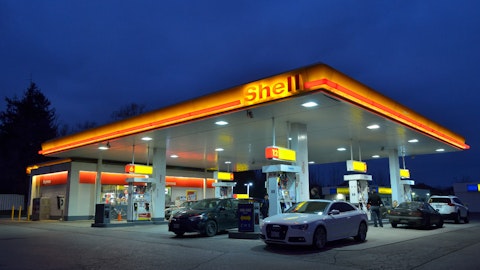Connor Lynagh: What’s your thinking around exploring potential alcohol to jet or other avenues to approach the SAF market.
Rich Walsh: Yeah, I think there’s two things. Obviously, what’s key to that is that the sequestration project has to go first. In order for ethanol to qualify for SAF, you have to get below the 50% GHG targets for the EU. And so if you look — if you assume that pipeline is done in the next couple of years, it will qualify our ethanol platform into SAF. And so the other thing that we’ve learned is with the SAF projects, you still have to blend that with conventional jet to make the final SAF product. So if you think about our platform, we have the ethanol, we have the carbon sequestration and we’ve got the conventional jet on the refining side. It does look like we would have a lot of advantage in just a complete supply chain into a finished SAF product. So that all looks like it’s something we will continue to look at as we get closer to reality on this carbon sequestration pipeline.
Connor Lynagh: All right. Thanks very much.
Operator: Thank you. The next question is coming from Neil Mehta of Goldman Sachs. Please go ahead.
Neil Mehta: Yes. Good morning, team and congrats on a great quarter. The first question was around jet cracks. We’re seeing that premium relative to diesel really blow out in some markets. Would love your perspective on — do you think there’s a structural premium in jet? And how do you see those premiums playing out over time?
Gary Simmons: Yes. So I think in the short-term, a lot of what you’re seeing, the premiums on jet are primarily in New York Harbor in the Florida market. And it’s still a bit of an overhang from the winter storm outages that we had in the US Gulf Coast, causing those markets to be exceptionally tight. It looks to us like probably mid-month in February, you’ll get some resupply, which will help jet supply in those regions. But overall, we expect jet demand to increase significantly this year and overall, a lot of tightness in the distillate markets.
Neil Mehta: That’s helpful. That to follow-up is around just the demand levels. I mean, we’ve historically anchored to EIA on some of the US demand levels and the numbers are noisy. I mean in the last four-week trailing number was down 11%, which is hard to reconcile with the fact that disti is 20% below the five-year from an inventory perspective in gasoline below the five-year as well. So just would love to hear what you’re seeing through your own wholesale system in terms of demand? And any thoughts on real-time color there?
Gary Simmons: Yes. So we share the view that the DOE numbers look low to us and we would expect them to be corrected going forward. Our wholesale numbers are trending pretty high. So gasoline volumes through our wholesale channel are about 12% above where they were pre-pandemic levels, which we don’t necessarily think is representative of the broader markets either. For us, I think the number which we focus on are more around the mobility data, which is kind of showing vehicle miles traveled flat to slightly above where it was pre-pandemic levels with some improvements in the efficiency of the fleet, it would say gasoline demand down maybe in the 2% range is what we kind of believe is most likely.
Neil Mehta: That makes more sense. Thanks, guys.
Operator: Thank you. The next question is coming from Jason Gabelman of Cowen. Please go ahead.
Jason Gabelman: Good morning. I got a couple of questions. First, I wanted to ask about the US Gulf Coast intermediate imports, the resids, and I understand some of that’s going to be backed out with the Port Arthur Coker project, but you’ll probably be taking some in-sell. And as these resid differentials have widened throughout the year, I imagine it’s been a pretty large benefit to your capture rates in 2022. So I was hoping you could help frame that? And if you expect resids the discount to stay wide in 2023 and continue to contribute to stronger captures despite your commentary that you expect some of the Russian VGO to be taken off the market? And I have a follow-up. Thanks.
Lane Riggs: So this is Lane. I’ll start on that. I mean, I think we’ll probably — we always look at heavy crude versus fuel oil. I mean one of the things that’s happened sort of Russia big buyers have been 100 out of Russia. And obviously, we don’t buy that anymore. So we’ve canvased the world and figured out alternative sort of fuel oil feedstocks and they’re plentiful largely based on what Gary has mentioned. I mean, you have a lot of incremental crude going into low complexity and they’re struggling making sulfur. So you can see that in the 3.5 weight percent discount to virtually everything else. And so we do believe that’s going to continue. I think through this year. So, at Valero, you’ll see us buy more heavy crude, we want post coker, and you’ll see us buy some more fuel oil and less intermediates.
Gary Simmons: Yes. So, the only thing I would add is for the full year 2022, resid probably didn’t have a significantly positive impact on our capture rates just because after the Russian sanctions and those barrels came off the market for really the second and third quarter, it was rebalancing the trade flows. But in the fourth quarter, we certainly saw a significant impact.
Jason Gabelman: Got it. Thanks. And my follow-up is on DGD. Given the start-up of DGD 3, I suspect there was a larger distribution to the joint venture partners. So, I was wondering if you’re willing to disclose what that distribution was? And now that you’re going to likely moving forward to have more access to the cash from DGD in the form of ongoing distributions, does that impact how you think about the payout ratio at all? Thanks.
Homer Bhullar: Maybe I’ll start on just on the DGD side, it just started up. We haven’t even got to the conversation with cash distributions yet. But the expectation is this year, it should be with capital spending coming to a close with the project that there should be more cash spinning off from the joint venture. I don’t know, Jason, if you comment–
Jason Fraser: Yes, that’s right. With having DGD 3 finish, we’ll have excess cash. And they’re always looking at new capital projects and maybe they’ll find another way to deploy it otherwise, there should be cash coming out. And we do include that in our calculus when we’re looking at payout ratios, but I guess that’s all I had on it.
Jason Gabelman: Got it. Thanks.
Operator: Thank you. The next question is coming from William — I’m sorry, Matthew Blair of TPH. Please go ahead.





